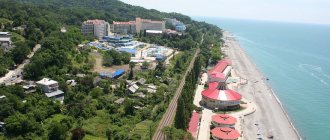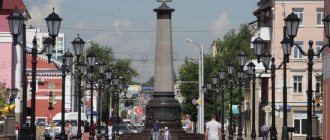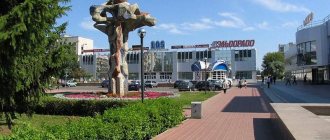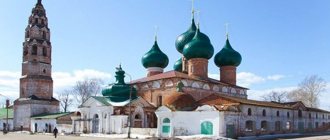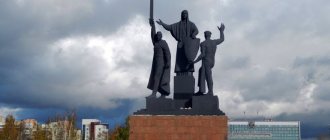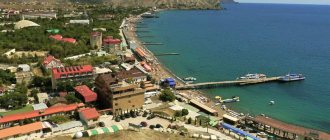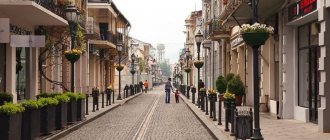Volga near Khvalynsk
The river is the main beauty and pride of the city. From the chalk mountains, at the foot of which Khvalynsk stands, a wonderful view of its banks and bends opens up. The width of the Volga near the city is 5-6 km, the opposite bank is almost invisible. When you stand right next to the water, and don’t look from above, the river seems like a sea.
On the right bank of the river in the Khvalynsk region there are many chalk hills, which in the Saratov steppes seem like mountains. They are overgrown with mixed and coniferous forests and create a picturesque picture around the city.
Geography of the area
The Khvalynsky district is conveniently located between the Volga and its tributary Tereshka, occupying the northern part of the right bank of the Saratov region. The historical border of the Middle and Lower Volga regions runs along the northern border of the region. The area of the district is 192 thousand hectares, the length from north to south is 60 km, the length of the dam is 3 km. The main highway is the Volga River, connecting the region with almost the entire European part of the Russian Federation. In the western part, the district is crossed by the Volga Railway with the Vozrozhdenie passenger station, and a republican highway stretches through the central part of the district from north to south. Khvalynsk is located at an equal distance of 230-240 km from the two largest centers of the region - Samara and Saratov. Created in 1967, the Saratov reservoir with a retaining dam in the city of Balakovo increased the previous low-water level of the Volga by 9 m at the upper pool near Balakovo and by 3.5 m at the lower pool near Samara. The width of the reservoir, which connected the regional center with the Zavolzhsky Dukhovnitsky ferry crossing, is 8 km near the city, and up to 20 km above the city.
Population - 29.6 thousand people, incl. in Khvalynsk - 14.4 thousand. There are 28 villages and towns in the region.
Picturesque chalk mountains, overgrown with relict vegetation and creating a healing microclimate, numerous springs have made the area most attractive for treatment, recreation and tourism.
There are deposits of high-quality chalk, sand and gravel. Natural forest plantations occupy 25.5 thousand hectares - 13.5 percent of the area. The Khvalynsky National Park is located on the territory of the region.
Apple orchards around Khvalynsk
In and around the city there are apple orchards that are widely known throughout the area. They encircle the city in a semi-ring and decorate it, sometimes with white color, sometimes with the ruddy sides of apples. Before the revolution, more than 50 tons of apples were exported from the pier along the Volga every year. Now new orchards have been established around the city, local gardeners continue the original Khvalyn traditions of growing apples.
Natural and gastronomic attractions
Lovers of the natural beauty that Mother Nature reveals to us will appreciate the caves, springs and gardens in Khvalynsk. Gourmets will be happy to taste local honey, apples and tea.
Apple orchards
- Address: Krasnoarmeyskaya street, 200B.
It is not without reason that apples are considered one of the symbols of Khvalynsk. The city is surrounded in a semicircle by apple orchards. They have been growing here since ancient times. In the imperial era, 50 tons of fruits were sent annually from the city along the waterway for sale. Now apples continue to be cultivated, preserving and reviving the traditions of local gardening.
Beekeeping farmstead Urman
- Address: st. Saratovskaya, 17.
In addition to apples, the Khvalynsky lands are famous for the production of honey. You can learn how this delicacy is born at the active beekeeping farm - the Urman farmstead, where interesting excursions are held. Visitors will not be left without tasting and delicious tea. Arriving at the farmstead, you can also improve your health with the help of “bee therapy.”
Monk's Cave
- Coordinates: 52.432983, 48.028550.
The mysterious natural monument on the territory of the national park has been known since the century before last; the time of the appearance of the cave is not known for certain. There are many legends surrounding the object.
It is called the “Monk’s Cave” because, according to sources, the hermit Seraphim lived here. For some time, the cave was also inhabited by an old woman named Fedora; it is believed that the artist Petrov-Vodkin came here in 1914.
Chalk cliffs
- Coordinates: 52.478192, 48.061206.
The most famous natural monument and the calling card of the national park are the hills formed on the Volga upland with snow-white peaks covered with green forest caps.
They look extremely picturesque and unusual. The “Three Cones” ridge, “Kalancha” mountain and the “Tashi” ridge are especially popular. The maximum height of the peaks of the chalk mountains can reach 370 meters.
Petryaninsky spring
- Coordinates: 52.440887, 48.042163.
Of the numerous springs of the national park, along with the life-giving spring in the Sergievsky monastery, the object that was ennobled by the efforts of the local experienced forester Vladimir Petryanin gained popularity. In honor of the “creator” it is called the Petryaninsky spring.
Aviary farm "Teremok"
- Address: Oktyabrskaya st., 2B.
On the border of the national park at the entrance to the city, various animals and birds live - deer, camels, pheasants, eagles and many others. A humpbacked representative of the fauna meets young naturalists and their parents right at the entrance to Teremok. The enclosure, which was originally created as a rehabilitation center and became a mini-zoo, has a fabulous name.
Art Gallery named after Petrov-Vodkin
Khvalynsk is the birthplace of the famous artist Kuzma Sergeevich Petrov-Vodkin. There is an art gallery named after him in the city, which displays paintings not only by the artist himself, but also by his friends.
The first painting for the future gallery was donated to the local history museum by Petrov-Vodkin himself. In 1931, the museum received Kuzma Sergeevich’s early work “The Artist’s Family.” In addition to paintings, the gallery exhibits a large collection of Old Believer icons, which were collected by local residents and brought from Trans-Volga monasteries.
Since the late 60s of the last century, many famous artists have donated their paintings to the museum, adding to the collection.
Location: Lenin street - 89.
Nature
The forests of the park's protected area consist of pines, lindens and oaks. Due to the predominance of the presented plant species, the forest area has become a habitat for numerous animals:
- mink;
- ferrets;
- roe deer;
- hares;
- wild boars;
- moose;
- fox;
- badgers;
- beavers
The hubbub of birds indicates that the reserve is home to a significant number of birds (black kite, common buzzard). You can organize an entertaining excursion to such a picturesque place yourself or book it in advance to take advantage of the unique opportunity to communicate with wild animals.
Don't miss the most popular article in the section: Metro Nizhny Novgorod. Diagram, map, description.
House-museum of the artist K.S. Petrova-Vodkina
The artist’s parents did not have their own home, and in 1905 Kuzma Sergeevich bought them a house, which has now been turned into a museum. Petrov-Vodkin often visited his parents here and painted many famous paintings, including the painting “Bathing the Red Horse.”
The museum houses the things of the artist and his family, and the furnishings of several rooms have been completely recreated. After Petrov-Vodkin’s death during the war, his widow and daughter lived here. In 1995, after the restoration of the house and the collection of exhibits, a museum was opened here.
Location: Lenin street - 89.
Administrative and municipal status
Within the structure of administrative units, Khvalynsk serves as the administrative center of Khvalynsky District,[4] although it is not part of it.[11] As an administrative division, together with four rural areas, included separately as Khvalynsk City of regional subordination
[11] - an administrative unit with a status equal to the status of districts.[
citation needed
] As a municipal entity, the City of Khvalynsk of regional jurisdiction, together with two rural settlements of the Khvalynsky district, is part of the Khvalynsky municipal district as
the Urban Settlement of Khvalynsk
.[5]
Plein airs “Khvalynsk etudes”
In the 80s of the last century, several Saratov artists went to Khvalynsk to sketch. These trips became annual. The Saratov artists, and after them many other young artists, come to the city to jointly discuss the ways of developing art and simply work in nature.
After all, Khvalynsk is not just the birthplace of the wonderful artist Petrov-Vodkin. This is a true Russian province that has preserved the spirit of peace and harmony with nature.
The results of these plein airs are exhibited in museums in Saratov and the region. Many works replenish the Khvalynsk art gallery. Plein airs have been taking place for three decades now, turning into real art festivals. Artists from all over the country come to the city. At one of the last holidays, a monument to Petrov-Vodkin was unveiled near the gallery.
Environmental and social problems of the park
The Khvalynsky Nature Reserve has national status and is considered the most visited park in the region, where more than 30,000 tourists come every year. Thanks to the work of recreational, protected and economic zones, new jobs have been created.
This complex of ecotourism also has economic significance. Bus and walking tourist routes are very popular among travelers.
The park's activities are aimed at:
- tourism development;
- improving the standard of living of the local population;
- attracting investments;
- expansion of the service sector in the region;
- increasing the economic independence of protected areas;
- introduction of mechanisms for public participation in decision-making processes;
- reducing the number of environmental violations;
- improvement of the condition of natural complexes;
- increasing the level of environmental culture of the region's population.
The protection of the territory is carried out by full-time state inspectors who patrol the area every day. Each of them is assigned a specific area, to which, during fire hazardous periods, increased attention is paid. The State Inspectorate for Nature Protection consists of 42 people. Every year, about 80 environmental violations are detected.
Frequent violations:
- illegal parking or movement of vehicles;
- violation of fire safety rules;
- forest pollution;
- illegal logging and fishing.
For violations, fines of up to 2,000 rubles are provided.
Khvalynsky Park, in order to protect natural complexes from bad anthropogenic influence, thanks to national support, created a protective zone with a regulated regime of economic activity (without changing the intended purpose of the land plots).
Fire prevention maintenance, explanatory work with visitors to the reserve, and campaigning through the media are being carried out.
Article design: Vladimir the Great
Khvalynsky Museum of Local Lore
The local museum of local history is one of the very first in the Volga region. It is located in the city center in two buildings. The museum was founded by the great-grandson of the writer A.N. Radishchev. At the end of the 19th century, it was the private collection of Mikhail Alekseevich Radishchev, who worked as a city judge at that time. The Khvalynsky Museum was opened for public use in his house.
Now this building houses exhibits telling about the history of Khvalynsk and the museum itself. On the second floor, M.A.’s office and rooms were recreated. Radishcheva.
The second building was built specifically for the museum in 1977. It houses the nature department. The exhibits are displayed in the form of dioramas. The beginning of the ornithological collection was laid by M.A. Radishchev.
Location: Petrova-vodkina street - 40.
Hotels nearby
Accommodation on the territory of the reserve in specially equipped houses varies from 500 to 1200 rubles. per day per person. At the Khvalynsky NP, children under 7 years old are accommodated free of charge. The most budget option: accommodation in a guest house, where you will have to pay 500 rubles per day. (for 1 person). In the “Sunny House” a night will cost 900 (houses No. 1, 2, 3) or 1200 rubles. (houses No. 4 and 5).
For relaxation, you can rent a gazebo for 200 rubles. or its “improved” version for 500 rubles. for 1 hour. A tea house will cost from 300 to 500 rubles. per hour, and you can rent a bathhouse for 800 rubles. at one o'clock.
The following hotels are located near the national park:
| Name | Address | Cost (RUB per day) |
| Park Hotel "Khvalynsky" | Pos. TO Cheremshany -2 | 2000 |
| Hotel "Khvalyn" | St. Rabochaya, 1V | 3300 |
| Guest House "On Proletarka" | St. Malaya Proletarskaya, 5 | 1100 |
| Hotel complex "Khvalynskaya Pearl" | St. Respubliki, 1l | 3500 |
Church of the Exaltation of the Holy Cross
Construction took place between 1906 and 1914. The style of the building is retrospectivism. The church was built with money from the Old Believer community by Saratov architect Yu.N. Terlikov. During the years of Soviet power, it was given to the plant as a warehouse. In 1946, the church was handed over to believers.
The church has a Sunday school and library. It is an architectural monument of regional significance.
Location: Dostoevsky street - 10.
Historical places: architecture of Khvalynsk
The attention of Khvalynsk tourists is also attracted by historical attractions - in particular, magnificent architecture and memorable places.
Estate "Alexandria"
- Address: st. Rabochaya, 1, pos. Northern, Khvalynsky district.
The estate of Counts Medem is located on the way from Khvalynsk to Syzran. The lands of the present village of Severny were acquired in 1874 by the parents of Alexander Medem - Otton Ludvigovich and his wife Alexandra Dmitrievna Naryshkina, in whose honor the estate was named “Alexandria”.
Much has been preserved from the estate complex. A two-story brick manor house stands on the shore of a pond. Under Alexander Ottonovich, a park was laid out around it. A steam mill, launched in 1907, is considered a landmark of the estate. This is where you get memorable photos.
House of merchant Koshcheev
- Address: Sovetskaya street, 44.
On Sovetskaya Street there is a beautiful red brick building with white decorative elements. Outwardly, it looks like a mansion; there is something fabulous in its appearance. In this little house lived a merchant with a surname similar to a folklore hero. In the sources he is called either Koshcheev or Kashcheev.
House of merchant N.S. Soldatkina
- Address: Republic Street 73a.
An elegant building with “turrets” is the creation of architect Yu.N. Terlikova is an example built in the neoclassical style in 1910. This is a residential mansion owned by merchant N.S. Soldatkin. Later, over the course of many years, new residents of Khvalynsk were born within its walls; a maternity hospital was located here.
Fire Tower
- Address: Kommunisticheskaya st., 9.
The fire tower building is considered an architectural monument and cultural heritage site of the city of Khvalynsk. The brick building dates back to 1896, and the history of firefighting in the city is much longer, part of it was first created here in 1781.
Dacha Mikhailov-Kuzmin
- Address: Russian Republic Street.
Near the banks of the Volga on the northern outskirts of Khvalynsk there is a building somewhat reminiscent of a castle. This house, interesting in its appearance, belonged to the merchants Mikhailov-Kuzmin and was used as a summer cottage. The construction dates back to 1912-1913, it is believed that its author could have been the famous architect Robert Friedrichovich Meltzer. In the Russian manner, the architect is called Roman Fedorovich.
Khvalynsky National Park
The Khvalynsky National Park was created around the city in 1946. This place turned out to be inaccessible to glaciers, so part of the vegetation of the pre-glacial period has been preserved here. A striking representative of rare species is chalk pine.
About a hundred rare and protected plant species grow here. There are walking tours along several routes throughout the park. You can see several fortifications that date back to the 6th century BC. The guides will tell you about nature and wildlife, climate characteristics, and holy springs located in the park. Several dozen springs with wonderful-tasting water come out of the ground.
In the park's enclosures you can see the inhabitants of these places. These animals were unable to live independently in the wild and ended up under human care.
Sights of Khvalynsk related to religion
In addition to the aforementioned Church of the Exaltation of the Cross, in Khvalynsk Orthodox Christians can visit a number of churches, and there is even a mosque for Muslims.
Garden of the Temples
- Address: st. Dostoevsky, 10.
In pre-revolutionary times, in Khvalynsk, with a population of 15 thousand, there were 20 Orthodox churches. Unfortunately, many of them have not survived. The landmark created on the territory adjacent to the Holy Cross Church is dedicated to historical memory. On the initiative of the rector of the church and local historians, the lost religious buildings were recreated in miniature. Thus, the “Garden of Temples” appeared in Khvalynsk.
Skete of St. Sergius of Radonezh and the source “Holy”
- Address: Khvalynsky National Park.
The Old Believer monastery of the Trinity Metochion of the Saratov Spaso-Preobrazhensky Monastery was founded in 1903. Its first rector was the Khvalyn elder Dorotheos. Nowadays the territory of the monastery belongs to a national park. About 300 natural springs have been discovered in the park.
One of the most popular - the "Holy" spring, or Life-Giving Spring - is located near the Sergius monastery. It is believed that it was thanks to him that the place was chosen by the monks for settlement. After the dispersal of the monastery during Soviet times, the spring was abandoned, but is now landscaped and pilgrimages are made to it.
Church of St. Nicholas the Wonderworker in the village of Popovka
- Address: st. 60th anniversary of the USSR, Popovka, Khvalynsky district.
In 1909-1910, construction of a stone church began in the village of Popovka, Khvalynsky district. The brick church, topped with five domes, was designed by the architect V. Petropavlovsky. The majestic temple operated until the 30s. XX century, after which it was closed, and its premises were used for grain storage. Today he has been restored and returned to religious life.
Cathedral Mosque
- Address: st. Narovchatova, 1.
The mosque in Khvalynsk is not a remake at all. The Muslim temple is more than a century old. Its history began back in 1898; the architectural project was created by Pyotr Kuznetsov, who worked as an art teacher. It was approved, but the mosque, built in 1903, was destroyed in a fire.
In its place in 1913, a new temple was built, which has survived to this day. In Soviet times, the mosque, naturally, did not work; cultural and leisure institutions were located within its walls. In 2001, it again began to accept Muslim citizens.
Monk's Cave near the Khvalynsky Mountains
Of constant interest to travelers is a cave carved into the mountains, in which monks lived until the beginning of the 20th century. It consisted of two separate rooms. One was used for prayers, in the second room the monks lived. This place is considered holy. From the mountain from the cave there is a beautiful view of the surrounding forests and the Volga.
Fauna
The fauna is represented by the following species diversity:
- birds - 187;
- mammals - 55;
- amphibians and reptiles – 16.
About 3,000 representatives of the insect class live in the reserve. Some of them are one of a kind and are protected in the Russian Federation. The park's avifauna is also characterized by wide diversity. Reptiles are represented by common and steppe vipers, quick and viviparous lizards, and snakes.
Ski resort "Khvalynsky"
A real ski resort has been created on the Khvalynsky Mountains. It is equipped with Austrian cable cars. From four trails you can choose a descent of your desired difficulty. Snow cannons cover the slopes with a good layer of snow, and illuminated slopes allow you to ski even at night. The imported equipment used creates real high-quality conditions for skiers and snowboard enthusiasts.
For visitors, a full range of ski equipment rental services is provided. The tourist complex offers Russian and Finnish baths, a spa, a hotel complex and separate houses for accommodation. This is a great opportunity for ski lovers to relax without making long trips to the Alps or the Caucasus.
In the summer season, vacationers appreciate interesting hiking trips around the resort, clean water from springs and the healing air of pine forests.
Entertainment in Khvalyn Park
The Khvalyn Recreation Park positions itself as a place for family recreation. In addition to skiing on slopes of varying difficulty levels, guests can expect:
- Spa complex . Among the procedures of the spa complex: all popular types of massages (classical, children's, anti-cellulite), stone/thalassotherapy, peelings and wraps, beer spa.
- Craft brewery . Khvalynsk craft beer brewery produces 3 varieties: 2 light (density 10% and 12%) and dark lager type. You can also try smoked beer and American ale at the brewery. On weekends, there are live music concerts from the best musical groups in the Saratov region.
- Russian baths . Among the bathhouses of the Khvalynsky resort there is a unique bathhouse, which is heated “black”. Smoke and the resulting soot have a beneficial effect on health, as they contain useful antiseptic substances.
- Children's activities : indoor playroom and outdoor area. During the high season, active games with animators are organized in the open area.
© Recreation Park "Khvalyn"
Excerpt characterizing Khvalynsk
True, everything seemed to Prince Andrei in a dark, gloomy light - especially after they left Smolensk (which, according to his concepts, could and should have been defended) on August 6, and after his father, sick, had to flee to Moscow and throw the Bald Mountains, so beloved, built and inhabited by him, for plunder; but, despite this, thanks to the regiment, Prince Andrei could think about another subject completely independent of general issues - about his regiment. On August 10, the column in which his regiment was located reached Bald Mountains. Prince Andrey received news two days ago that his father, son and sister had left for Moscow. Although Prince Andrei had nothing to do in Bald Mountains, he, with his characteristic desire to relieve his grief, decided that he should stop by Bald Mountains. He ordered a horse to be saddled and from the transition rode on horseback to his father’s village, in which he was born and spent his childhood. Driving past a pond, where dozens of women were always talking, beating rollers and rinsing their laundry, Prince Andrei noticed that there was no one on the pond, and a torn raft, half filled with water, was floating sideways in the middle of the pond. Prince Andrei drove up to the gatehouse. There was no one at the stone entrance gate, and the door was unlocked. The garden paths were already overgrown, and calves and horses were walking around the English park. Prince Andrei drove up to the greenhouse; the glass was broken, and some trees in tubs were knocked down, some withered. He called out to Taras the gardener. Nobody responded. Walking around the greenhouse to the exhibition, he saw that the wooden carved fence was all broken and the plum fruits were torn from their branches. An old man (Prince Andrei saw him at the gate as a child) sat and weaved bast shoes on a green bench. He was deaf and did not hear Prince Andrei's entrance. He was sitting on the bench on which the old prince liked to sit, and near him was hung a stick on the branches of a broken and dried magnolia. Prince Andrei drove up to the house. Several linden trees in the old garden were cut down, one piebald horse with a foal was walking in front of the house between the rose trees. The house was boarded up with shutters. One window downstairs was open. The yard boy, seeing Prince Andrei, ran into the house. Alpatych, having sent his family away, remained alone in Bald Mountains; he sat at home and read the Lives. Having learned about the arrival of Prince Andrey, he, with glasses on his nose, buttoned up, left the house, hastily approached the prince and, without saying anything, began to cry, kissing Prince Andrey on the knee. Then he turned away with his heart at his weakness and began to report to him on the state of affairs. Everything valuable and expensive was taken to Bogucharovo. Bread, up to a hundred quarters, was also exported; hay and spring, extraordinary, as Alpatych said, this year’s harvest was taken green and mowed - by the troops. The men are ruined, some also went to Bogucharovo, a small part remains. Prince Andrei, without listening to him, asked when his father and sister left, meaning when they left for Moscow. Alpatych answered, believing that they were asking about leaving for Bogucharovo, that they left on the seventh, and again went on about the shares of the farm, asking for instructions. – Will you order the oats to be released to the teams against receipt? “We still have six hundred quarters left,” Alpatych asked. “What should I answer him? - thought Prince Andrei, looking at the old man’s bald head shining in the sun and reading in his facial expression the consciousness that he himself understood the untimeliness of these questions, but was asking only in such a way as to drown out his own grief. “Yes, let go,” he said. “If you deigned to notice disturbances in the garden,” said Alpatych, “it was impossible to prevent: three regiments passed through and spent the night, especially the dragoons.” I wrote down the rank and rank of commander to submit the petition. - Well, what are you going to do? Will you stay if the enemy takes over? – Prince Andrei asked him. Alpatych, turning his face to Prince Andrei, looked at him; and suddenly raised his hand upward with a solemn gesture. “He is my patron, his will be done!” - he said. A crowd of men and servants walked across the meadow, with their heads open, approaching Prince Andrei. - Well, goodbye! - said Prince Andrei, bending over to Alpatych. - Leave yourself, take away what you can, and they told the people to go to Ryazan or Moscow Region. – Alpatych pressed himself against his leg and began to sob. Prince Andrei carefully pushed it aside and, starting his horse, galloped down the alley. At the exhibition, still as indifferent as a fly on the face of a dear dead man, an old man sat and tapped his bast shoe, and two girls with plums in their hems, which they had picked from the greenhouse trees, ran from there and stumbled upon Prince Andrei. Seeing the young master, the eldest girl, with fear expressed on her face, grabbed her smaller friend by the hand and hid with her behind a birch tree, not having time to pick up the scattered green plums. Prince Andrei, frightened, hastily turned away from them, afraid to let them notice that he had seen them. He felt sorry for this pretty, frightened girl. He was afraid to look at her, but at the same time he had an irresistible desire to do so. A new, gratifying and calming feeling came over him when, looking at these girls, he realized the existence of other, completely alien to him and just as legitimate human interests as those that occupied him. These girls, obviously, passionately desired one thing - to carry away and eat these green plums and not be caught, and Prince Andrei wished with them the success of their enterprise. He couldn't help but look at them again. Believing themselves to be safe, they jumped out of the ambush and, squealing something in thin voices, holding their hems, ran merrily and quickly through the grass of the meadow with their tanned bare feet. Prince Andrei refreshed himself a little by leaving the dusty area of the high road along which the troops were moving. But not far beyond the Bald Mountains, he again drove onto the road and caught up with his regiment at a halt, near the dam of a small pond. It was two o'clock after noon. The sun, a red ball of dust, was unbearably hot and burned my back through my black frock coat. The dust, still the same, stood motionless above the chatter of the humming, stopped troops. There was no wind, and while driving across the dam, Prince Andrei smelled the mud and freshness of the pond. He wanted to get into the water - no matter how dirty it was. He looked back at the pond, from which came screams and laughter. The small, muddy, green pond had apparently risen about two quarters high, flooding the dam, because it was full of human, soldier, naked white bodies floundering in it, with brick-red hands, faces and necks. All this naked, white human meat, laughing and booming, floundered in this dirty puddle, like crucian carp stuffed into a watering can. This floundering was filled with joy, and that is why it was especially sad. One young blond soldier - Prince Andrei knew him - of the third company, with a strap under his calf, crossing himself, stepped back to take a good run and splash into the water; the other, a black, always shaggy non-commissioned officer, waist-deep in water, twitching his muscular figure, snorted joyfully, pouring water on his head with his black hands. There was the sound of slapping each other, and squealing, and hooting. On the banks, on the dam, in the pond, there was white, healthy, muscular meat everywhere. Officer Timokhin, with a red nose, was drying himself on the dam and was ashamed when he saw the prince, but decided to turn to him: “That’s good, your Excellency, if you please!” - he said. “It’s dirty,” said Prince Andrei, wincing. - We'll clean it up for you now. - And Timokhin, not yet dressed, ran to clean it. - The prince wants it. - Which? Our prince? - voices spoke, and everyone hurried so much that Prince Andrey managed to calm them down. He came up with a better idea to take a shower in the barn. “Meat, body, chair a canon [cannon fodder]! - he thought, looking at his naked body, and shuddering not so much from the cold as from an incomprehensible disgust and horror at the sight of this huge number of bodies rinsing in the dirty pond. On August 7, Prince Bagration, in his Mikhailovka camp on the Smolensk road, wrote the following: “Dear Sir, Count Alexei Andreevich. (He wrote to Arakcheev, but knew that his letter would be read by the sovereign, and therefore, as far as he was capable of it, he thought about his every word.) I think that the minister had already reported on the abandonment of Smolensk to the enemy. It’s painful, sad, and the whole army is in despair that the most important place was abandoned in vain. I, for my part, asked him personally in the most convincing way, and finally wrote; but nothing agreed with him. I swear to you on my honor that Napoleon was in such a bag as never before, and he could have lost half the army, but not taken Smolensk. Our troops fought and are fighting like never before. I held 15 thousand for more than 35 hours and beat them; but he didn’t want to stay even 14 hours. This is shameful and a stain on our army; and it seems to me that he himself should not even live in the world. If he reports that the loss is great, it is not true; maybe about 4 thousand, no more, but not even that. Even if it’s ten, there’s war! But the enemy lost the abyss...
Population
| Population | ||||||
| 1856[5] | 1897[6] | 1913[5] | 1926[5] | 1931[5] | 1939[7] | 1959[8] |
| 12 900 | ↗15 127 | ↗17 300 | ↘9600 | ↗11 800 | ↗15 642 | ↗17 036 |
| 1967[5] | 1970[9] | 1979[10] | 1989[11] | 1992[5] | 2000[5] | 2001[5] |
| ↘17 000 | ↘16 249 | ↘15 572 | ↘14 948 | ↘14 900 | ↘14 800 | ↘14 700 |
| 2002[12] | 2003[5] | 2005[5] | 2006[5] | 2009[13] | 2010[14] | 2011[15] |
| ↘13 752 | ↗13 800 | ↘13 600 | →13 600 | ↘13 414 | ↘13 094 | ↘13 044 |
| 2012[16] | 2013[17] | 2014[18] | 2015[19] | 2016[3] | ||
| ↘12 947 | ↗13 005 | ↘12 985 | ↘12 814 | ↘12 788 | ||
As of January 1, 2016, in terms of population, the city was in 849th place out of 1,112[20] cities in the Russian Federation[21]
Interesting Facts
- The city is mentioned in Leonid Gaidai’s comedy “Operation “Y” and other adventures of Shurik” (short story “Partner”):
Our construction and installation department has built an amount of residential space that is equal to one city like Chita, ten cities like Khvalynsk, or thirty-two Kryzhopoly.
- In 1990, the feature film “The Enchanted Wanderer” based on the story of the same name by Nikolai Leskov was shot in Khvalynsk and the surrounding area.

